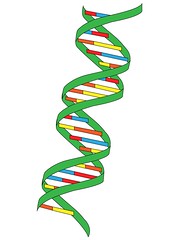| 9000378439 | DNA | nucleic acid that makes up your genetic code; located in the nucleus of cell |  | 0 |
| 9000378440 | Genes | segments of DNA that code for proteins, thus determining our various traits and allowing us to pass on heritable traits from generation to generation |  | 1 |
| 9000378441 | Frederick Griffith | British medical officer who studied the bacterium that causes pneumonia; discovered bacterial transformation via an experiment that involved injecting mice with smooth S cells, rough R cells, heat-killed S cells, and heat-killed S cells with living R cells. |  | 2 |
| 9000378442 | R-strain bacteria | Strain of Streptococcus pneumoniae that does not cause pneumonia (you'll be R RIGHT if infected by this one) |  | 3 |
| 9000378443 | S-strain bacteria | Strain of Streptococcus pneumoniae that causes pneumonia (it would be SO BAD to be infected by this one) |  | 4 |
| 9000378444 | Transforming principle | Name that Griffith gave to the factor that turned harmless R-strain bacteria into virulent S-strain bacteria when dad S-strain bacteria were mixed with living R-strain bacteria. |  | 5 |
| 9000378445 | Bacterial transformation | The ability of bacteria to take up DNA from another bacterial cell and incorporate it into their own genome. Discovered by Griffith in his experiments on the bacterium that causes pneumonia. |  | 6 |
| 9000378446 | Oswald Avery | Verified Griffith's experiment. He used specific enzymes to see which macromolecule, if destroyed, would not cause death in the mouse. Found that DNA that had been broken down would not cause death. |  | 7 |
| 9000378447 | Hershey and Chase | The two scientists who wanted to determine which part of a bacteriophage virus entered a bacterial cell: the DNA or the protein coat. They made the proteins radioactive, and the radioactivity was NOT injected into the cell. They made the DNA radioactive, and the radioactivity WAS injected into the cell. |  | 8 |
| 9000378448 | Bacteriophage | A virus that infects bacteria |  | 9 |
| 9000378449 | 1953 | Year that Watson and Crick published the structure of DNA. | 10 | |
| 9000378450 | James Watson and Francis Crick | Scientists that are given credit for establishing the structure of the DNA molecule as a double-helix. |  | 11 |
| 9000378451 | Rosalind Franklin | British scientist who used a technique called X-ray diffraction to get information about the structure of the DNA molecule; Watson and Crick used her photo without her permission to develop their model of the structure of DNA. |  | 12 |
| 9000378452 | Maurice Wilkins | Worked alongside Rosalind Franklin on taking photographs of DNA using X-ray diffraction; showed Franklin' image to Watson and Crick without her permission. |  | 13 |
| 9000378453 | Double Helix | The twisted ladder structure of DNA. |  | 14 |
| 9000378454 | X-Ray Crystallography | A technique that depends on the diffraction of an X-ray beam by the individual atoms of a crystallized molecule to study the three-dimensional structure of the molecule; used by Franklin to study the structure of DNA |  | 15 |
AP Biology Unit 4.1: Discovery of DNA Flashcards
Primary tabs
Need Help?
We hope your visit has been a productive one. If you're having any problems, or would like to give some feedback, we'd love to hear from you.
For general help, questions, and suggestions, try our dedicated support forums.
If you need to contact the Course-Notes.Org web experience team, please use our contact form.
Need Notes?
While we strive to provide the most comprehensive notes for as many high school textbooks as possible, there are certainly going to be some that we miss. Drop us a note and let us know which textbooks you need. Be sure to include which edition of the textbook you are using! If we see enough demand, we'll do whatever we can to get those notes up on the site for you!

